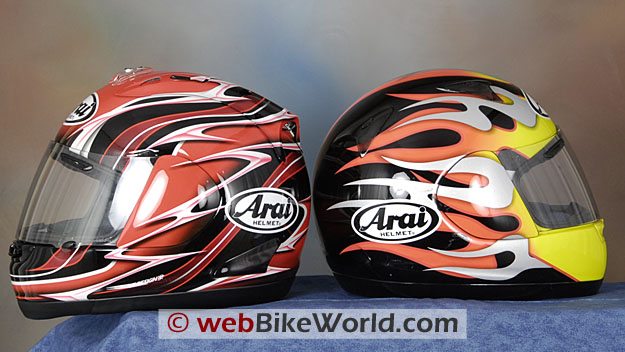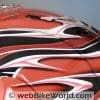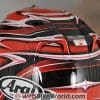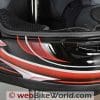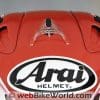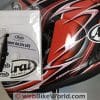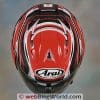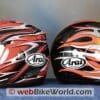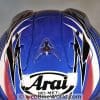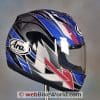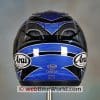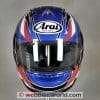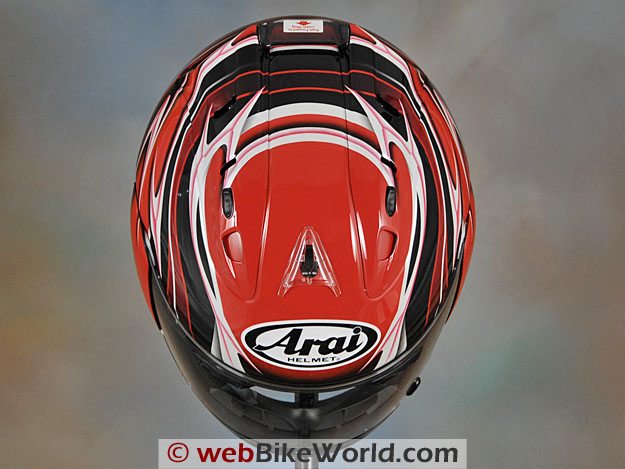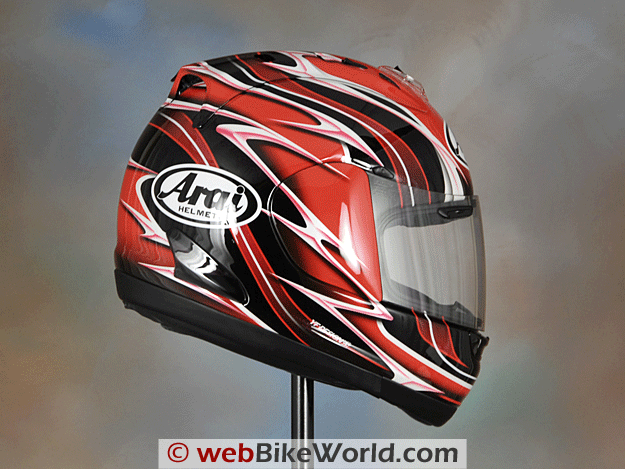The flagship of the Arai helmet lineup, the new Corsair V is an evolution of the RX-7, one of the most popular motorcycle racing helmets ever made.
This is an evolution, not a revolution, but it should satisfy Arai fans everywhere.
This marks our 108th motorcycle helmet review, but after all this time, we still haven’t gotten around to what surely must be the most widely recognized motorcycle helmet of all time, the pre-2009 Arai RX-7 Corsair.
I’ve worn an RX-7, and we had one come through the studio for photos before it went to Kris Turner, the motorcycle racer (photos below).
But we just never got around to doing a full evaluation of the famous helmet, so I can’t compare it to the new Corsair V, but I can definitely compare it to most of the other helmets we’ve reviewed.
In fact, the number of helmets that come through here each year tends to jade one’s perceptions a bit.
Helmets come and helmets go, and I daresay we wear more helmets in one year than most riders own in their lifetime, which gives a much wider perspective on what works and what doesn’t.
For diehard Arai or RX-7 owners, the Corsair V is the Holy Grail of helmets; nothing else comes close or will be considered.
They may not ever know how good the competition has become over the past few years, and I believe that point is relevant to this discussion.
Now known as the Arai Corsair V in North America and the Arai RX-7 GP in Europe, this is the flagship of the Arai helmet line.
It’s their pinnacle of achievement; everything they know about motorcycle helmets has been poured into the Corsair V and this is reflected in the price; which, like it or not, is an issue, so let me address it first.
The Corsair V carries a current list price of $739.95 to $754.95 for solids up to $869.95 for the replicas, like the red Randy Mamola replica shown here.
Regular webBikeWorld visitors know that the higher the price, the more powerful our microscope.
This means that slight flaws that might otherwise go unreported on a buck-fifty lid can be fatal on a helmet that leaves just a handful of change from a Grover Cleveland (yes, the U.S. once had $1,000.00 bills). So keep that in mind when reading this review.
There’s something of a dilemma here also.
Other than the highly impractical method of crash testing a variety of helmets to see which one provides the highest levels of protection, a motorcyclist can only compare this most important function of a motorcycle helmet by ensuring that the relevant safety standards have been met.
This means that in theory, a helmet meeting DOT, ECE, JIS, AS, Snell or whatever safety standard should offer the same level of protection, whether it costs $100.00 or $1,000.00.
Other than that, it’s a matter of fit, comfort and quality of the fittings.
The dilemma is that many or even most of today’s inexpensive helmets have very high levels of quality; indeed, some have quality levels far exceeding even the most expensive helmets of just a few years ago.
So the once dramatic difference between cheap and expensive helmets is no longer quite as apparent.
The Arai RX-7 Corsair V
So then the question becomes what, exactly, does the Corsair V get you for the extra $700.00 or so that it costs over one of the high-quality $150.00 helmets meeting the same safety standards?
The answer probably comes down to owner choice based on subtleties, biases and perceptions. Some motorcyclists swear by their RX-7 and, by default, the Corsair V, while others will be chuckling all the way to the bank.
After all, 850 bucks could buy you a nice helmet and a full riding outfit, or a nice helmet and enough money left over for a motorcycle vacation, or, if you’re lucky, a nice helmet and a rat bike…
I’ll have to leave the decision about the value proposition to you. I will admit though that I’m slightly underwhelmed.
Sure, the RX-7 has a great reputation, but when I think about all the great helmets we’ve reviewed in the past year, it’s difficult to justify the Corsair V as $700.00 better.
The fact is that the Corsair V pretty much feels like a — well, like a motorcycle helmet. It isn’t revolutionary. It has a vent system on top and a well-executed but basic feature set.
It’s not a super-lightweight, so the extra money isn’t shaving ounces either — in fact, at 1758 grams, the helmet is actually rather heavy for its type.
Granted, the Corsair V has superb quality — but then again, so do many other helmets I can think of, like, for example, the Shark RSX (review) or even that $150.00 SparX S-07 or Urban N20 Astro. Heresy, you say!
How could you possibly compare the Arai with those cheap lids? Answer: please refer to Paragraph 3 above.
So the Corsair V leaves me slightly puzzled. I guess with all the hoopla, I was expecting more. $850.00 is a lot of money in any economy, much less the 2009 version of the same.
How do we really know that we’re buying any more protection for that money over, say, the KBC Tarmac (review), which also meets Snell and DOT safety standards and which can be found for a street price around $79.00?
Possibly a rhetorical question, but that’s why we’re here — to get you thinking!
Paint, Graphics and Overall Quality
This Corsair V exhibits excellent overall quality, with paint, fittings and finish all nearly flawless. The only very slight problem I can find on this example is in the way the cheek pads are fitted to the helmet.
The material is slightly bunched up towards the front of each cheek pad, making it appear that either the cheek pads were forced into place or that the design or sizing is off slightly.
I’m particularly worried about this because the cheek pads on my Arai Quantum II (review) quickly deteriorated and have been giving me problems pretty much since the helmet was new.
Otherwise, the Corsair V looks fantastic and the paint and graphics are all carefully applied, although Arai is usually much more conservative in their choice of colors and patterns than, say, Suomy for example.
But again, the quality of some of the low-priced helmets has become so good that the differences between Arai quality and the rest are much harder to discern than ever.
So I can’t really say that the quality of the Corsair V is an order of magnitude better than everything else.
What I can say is that it’s a very well made helmet and the quality is there…but the level of competition is so high that consumers now expect a high level of quality in any helmet purchased, regardless of the price.
The movement and operation of the vents is probably better though on this Corsair V than many or most of the other helmets we’ve evaluated.
This seemingly simple function is often overlooked by other manufacturers.
The Corsair V has the standard Arai vent system, with the snap-down, two-position chin vent and integrated filter, the fibers of which, I believe, are impregnated with activated charcoal.
The brow vents in the visor and some extra venting on top that I’ll get into in a minute. All of the vent covers and closures snap tight and secure.
One feature that’s a bit out of snuff on this particular helmet is the visor. I can live without the detents, but the visor seems to have too much back-and-forth play on this helmet and it doesn’t quite seal perfectly against the eye port.
Also, something I’ll get into in a moment, the dimensions of the eye port opening are smaller than average, which is a surprise to me.
The liner is nicely made and comfortable, although the inner fabric (closest to the rider’s head) is not as plush as the fabric used in my Quantum II.
Score: I’ll give the Arai Corsair V an “Outstanding” rating for overall quality. See the Summary Table at the end of this page for a description of our rating system.
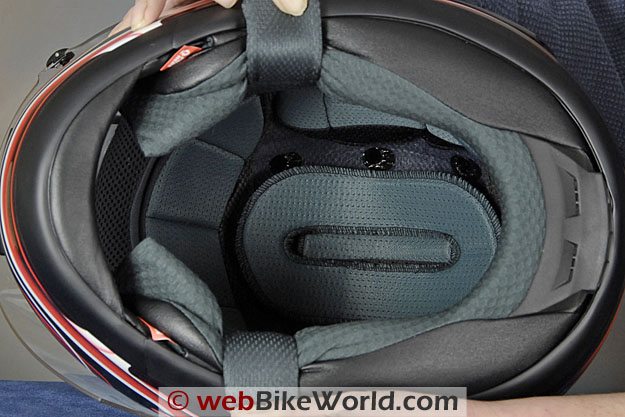
Helmet Fit, Internal Shape, Liner and Comfort
As far as I know, Arai is still the only helmet manufacturer to make helmets for different head shapes.
Why other manufacturers haven’t caught on to the fact that human heads come in a variety of shapes and sizes is beyond me, and Arai has keenly exploited this feature of their designs to great effect.
One thing about this is curious though: Arai continuously updates their website about once per year, but the latest version has no fit information that I can find.
So the company that’s obsessed with correct fit doesn’t have a list showing the helmet fit classifications by model type; i.e., which helmets are Long Oval, which are Round Oval, and which are Intermediate Oval?
We’ve searched for information on helping customers find the correct size helmet also and can’t find it, so perhaps it’s either well hidden or missing?
My size XL Arai Quantum II fits my head shape better than any other helmet I’ve ever worn — and I’ve worn well over 100.
The Quantum’s padding has compressed slightly over time and the liner and cheek pads have been removed more times than is probably recommended, making the helmet too loose at this point.
I’m waiting for a Quantum III to replace it, but in the meantime, the Arai Corsair V, with the Arai “Intermediate Oval” shape, fits me very nicely indeed.
It feels about 1/2 to 1 size tighter than the Quantum in the cheeks, although this may have more to do with the saggy cheek pads on my Quantum than anything else.
The Corsair V feels like it has a very slight oval shape up top; I can just squeeze a pinky finger up above my brow, which means to me that the Corsair V is slightly more “football shaped” than the Quantum II at the top of the helmet.
What is interesting is that this Corsair V with its Intermediate Oval shape feels rounder than the Arai Vector we reviewed, which Arai says also has an Intermediate Oval shape.
The size XL Vector feels (or felt) too narrow for me to wear, while the Corsair V feels nearly perfect.
This may be due to the “race fit” of the Corsair V. Some helmets that are designed primarily for motorcycle racing fit that more snugly than their corresponding size in a street bike helmet.
The Corsair feels about 1/2 size smaller than my XL Quantum II did when it was new.
Other than the slightly snug cheeks, the liner itself is comfortable and it feels firm. This keeps the Corsair planted on my head and the helmet feels very nicely balanced.
I’d say the internal shape of the Corsair V is similar to the Shoei RF-1000 (review) but not quite as “Long Oval” as the Shark RSX (review) or the Scorpion EXO-700 (review).
The Corsair V also feels like it’s in between the Vector and the Quantum. So in this case, I think the Arai Intermediate Oval shape is very much a “neutral” to round fit, and it should actually work for the majority of head shapes.
For more information about head shapes and choosing and fitting a motorcycle helmet, please see the wBW Motorcycle Helmet FAQ page, which also includes a discussion on head shapes.
As always, remember that helmet fit is crucial to safety and comfort, so make sure you try the helmet on before buying, and try a variety of sizes. The smallest size that fits comfortably is usually the safest.
The Corsair V includes Arai’s small chin spoiler, which folds up into the chin bar.
I don’t really notice much of a difference in air flow, noise levels or turbulence whether it’s up or down, but then again I’m not riding at 150 MPH either.
Score: I’ll give the Corsair V an “Outstanding” for a comfortable fit, a nicely constructed and comfortable liner with comfortable liner material.
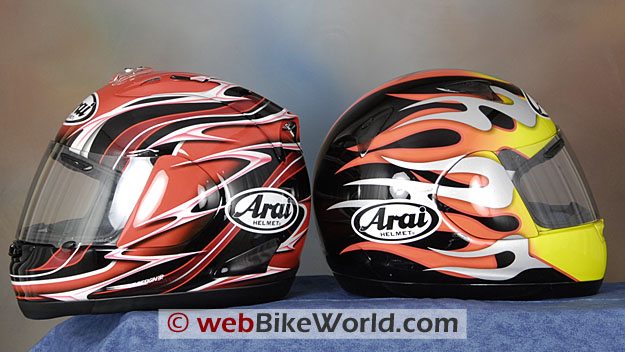
Ventilation and Air Flow
The Corsair V has the potential for good ventilation, but it’s difficult to determine exactly how much air flow it provides at this time because we’re deep into winter as I write this and the cold, cold air simply feels like it’s blowing in from everywhere.
So a full study of the helmet’s ventilation system will have to wait.
The helmet has three top vents, including a large clear plastic scoop in the center that makes no amends towards style; it’s strictly for function.
The three vents open and close with the standard Arai snap covers, and each vent cover operates with the same small rocker switch found on other Arai helmets.
And like the Quantum II reviewed several years ago, they’re still just as tiny and difficult to find when wearing winter gloves.
The Corsair V also has dual rear exhaust vents at the end of each channel that runs along the top of the helmet. These can be opened or closed via a sliding cover, again similar to other Arai helmets, including the Quantum II.
I always leave the exhaust vents open on any helmets so equipped, and I’m not sure why the manufacturers even bother with the switch.
The dual channel venting system attached to the top of the Corsair looks a bit old-fashioned to me. Remember only a couple of years ago when just about every full-face helmet around had a “Boy Racer” vent system like this?
Most helmets now have smaller and less obtrusive systems, many of which still manage to flow a good amount of air with low noise levels.
In fact, it’s been some time since we’ve complained of the “Coke Bottle” whistling noise from top vents because the manufacturers have pretty much got this wired. Unfortunately, the scoops on top of the Corsair V bring back these memories.
The Corsair V also features the standard Arai flip-down, two-position chin vent.
This one works very well and the difference between closed and open is readily apparent, although there’s still a lot of air that flows up underneath the chin bar, same as most helmets.
The chin vent splits the air flow, directing some of it down through a screened vent opening in the back of the chin bar and the rest up in back of the visor. All of the vents work very well, with a solid feel and no play.
Score: Difficult to determine true air flow until the hot weather arrives, but this one has potential, so I’ll give it an “Excellent” rating.
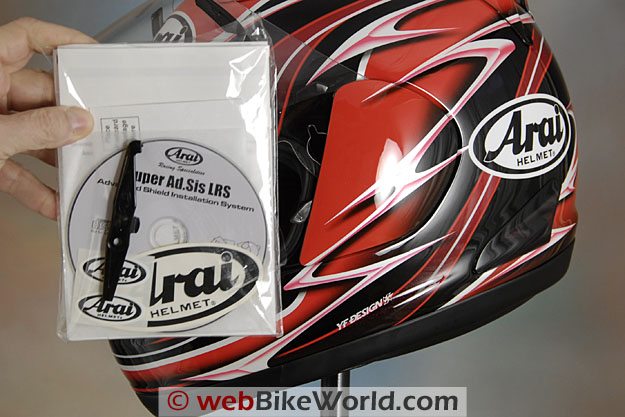
Helmet Weight
The Corsair V felt slightly heavy when first handled, which is surprising, as I thought at least some of the cost of the helmet would be due to high-tech materials that would make the helmet very light weight.
Indeed, at 1758 grams for this size XL, the Corsair V is in the upper 25 percentile of helmet weights of the 108 we’ve reviewed to date.
For reference, this is much heavier than some of the helmets in its class, like the HJC FS-15 Carbonat 1514 grams (3 lbs. 5-3/8 oz.) or the AGV Stealth at 1536 grams (3 lbs. 6-1/4 oz.).
Also the Suomy Extreme Spec-1R at 1570 (3 lbs. 7-3/8 oz.) and the Arai Vector 1583 (3 lbs. 7-7/8 oz.) all in size XL.
For reference, the Shark RSX in size large that we reviewed is 1553 grams (3 lbs. 6-3/4 oz.).
I’m not sure why the Corsair V weighs as much as it does, because some of the other helmets mentioned also meet both DOT and Snell safety standards with less mass.
Fortunately for me, the snug fit and excellent balance counteract the weight, making for a good feel when riding.
Be sure to visit the wBW Motorcycle Helmet Weights page for charts comparing the weights of all of the open-face, full-face and flip-up helmets we’ve reviewed.
Score: The Arai Corsair V gets a “Good” rating for what I think is a heavier than expected (in this class of helmet) weight with good balance.
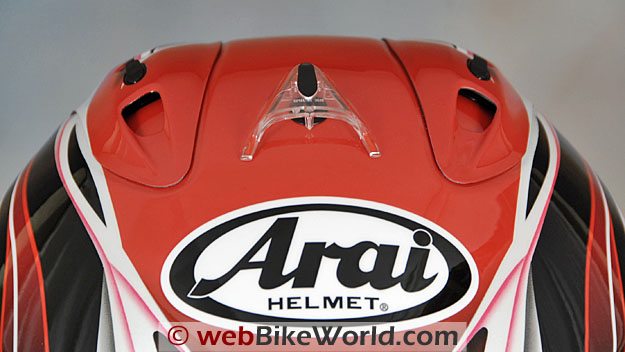
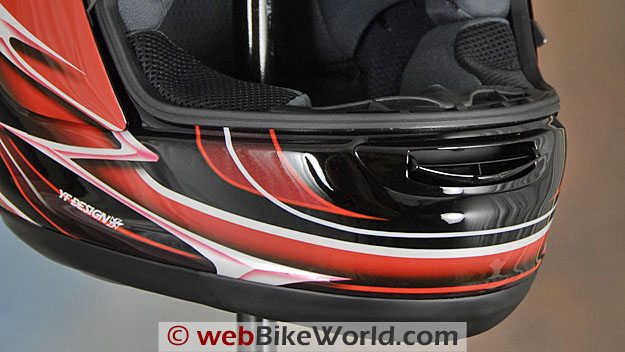
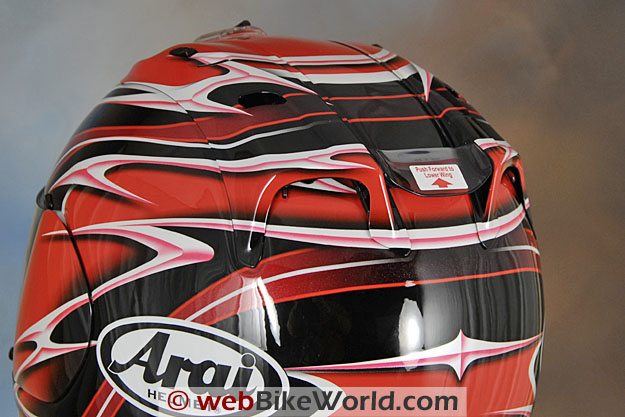
Face Shield
One of the reasons Arai build quality is so good could be the reuse of many components across the product line.
The idea is that once a component or system has been developed, tested and proven, it just makes sense to use it as much as possible.
This also has the side benefit of amortizing the R&D and manufacturing expense over a greater number of units.
The potential downside is becoming so locked in to a particular way of doing things that innovation is stifled. I’m not sure if that’s the case here, but it would be nice to see something different in the way of hardware on an $850.00 helmet.
The face shield used on the Corsair V is also standard Arai parts bin.
It has the Arai snap lock-down on the lower left side to keep it secure at speed and it raises and lowers with friction, rather than detents.
The face shield on this helmet is slightly creaky and loose side-to-side, but overall it works well, although it’s sometimes difficult to set it at the desired opening.
The face shield also has a slight gap where it meets the eye port gasket, a surprising quality issue that thankfully doesn’t seem to affect performance.
It’s possible that the friction face shield holding mechanism and the complex Arai face shield removal system make it difficult to meet the tolerances necessary to keep the face shield tightly fitted against the gasket.
Which brings us to the issue of the Arai face shield removal system. Some owners report no problems with this system, while others — yours truly — aren’t too keen on it.
I discussed this at length in my review of the Quantum II and I’m sorry to say that the system hasn’t changed much.
In fact, the helmet now comes with a CD-ROM video instruction guide on removing the face shield (and the video isn’t all that helpful), along with a strange-looking plastic tool (see photo) designed to remove the side pods, face shield and tighten up the mechanism.
I’m definitely an experienced motorcycle helmet owner — after all, not many motorcyclists have nearly 100 helmets of all different types sitting on their shelves.
But I’ve watched the Arai videos, read the instructions, watched the YouTube and even had the Arai representatives at the Dealer Expo show me how its done (he flubbed it, by the way).
And I’ve decided that removing the face shield on an Arai helmet is something that I personally would rather not experience if I don’t have to.
Fortunately, I rarely need to change face shields because of the number of helmets we have on hand, so this doesn’t affect me as much as it will some others.
I do have the sneaking suspicion that Arai isn’t going to change the system only to prove a point and not lose face.
Watch our helmet review videos and you’ll find any number of modern helmets that have incredibly easy face shield removal systems that don’t require specially painted side pods.
Holding the inventory alone for all the different colors and graphics must cost Arai (and the distributors and dealers) a fortune.
I’m not alone, either. We get a continuous stream of email from webBikeWorld Arai owners on this topic, and I’d estimate that 9 out of 10 owners report problems with the Arai system.
So after carefully watching the videos and reading the owner’s manual several times, I tried again to remove and replace the face shield on the Corsair.
But I had so much trouble with it that we decided not to include it in our video for fear of breaking the face shield and/or the side pods. Been there; done that. No m’s, gracias.
| Arai Corsair V: wBW Lightbox – Click Photo to View. | |||||
|---|---|---|---|---|---|
 |
 |
 |
|||
 |
 |
 |
|||
| The previous version of the Arai Corsair V: the Arai RX-7. | |||||
Back to the face shield, which measures 2.1 mm thick and has good optical properties. Just for the record, the Shark RSX helmet face shield measured 3.2 mm, a full 30% thicker.
The Corsair V face shield also has proven to be very resistant to fogging so far in our cold winter weather.
The eye port opening on the Corsair V seems narrower and shorter than the average helmet in our stable, again surprising for a race helmet where excellent outward visibility is paramount.
Arai claims the eye port is 10 mm wider (5 mm on each side) than the RX-7, but it could be wider still, in my opinion.
It’s not as narrow as the Shark RSX, but the eye port definitely does not feel like it’s as large as the GMax GM68S (review), my favorite for visibility.
The top of the liner in the eye port is also in my line of sight, especially when leaned forward in a forward tuck, as in a Sportbike riding position. This may be due to Arai’s “Peripheral Belting” system that reinforces the brow of the helmet shell.
Score: I’ll give the face shield system a “Good”, for operation and visibility, anti-fog capabilities and clarity.
But it gets a “Poor” from me for a difficult removal system, the separate ear pods (I’ve broken a set on the Quantum trying to remove the face shield) and the slight gap between the eye port gasket and face shield.
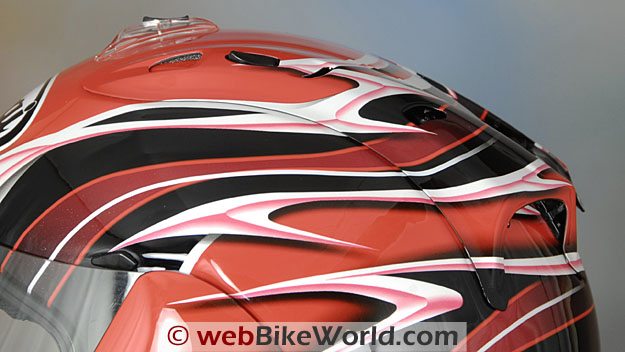
Noise Levels
I don’t recall anyone ever saying the RX-7 was a quiet helmet, and the Corsair V will probably be no different.
At least the close fit and good aerodynamics seem to prevent most of the low-frequency booming noises caused by turbulence around the bottom of the helmet.
The upper vents are the real culprit here, with lots of air rushing noise when the vents are open.
It gets louder as the riding position becomes more upright and quieter as the rider leans forward; this helmet was clearly meant to be used in the Sportbike tuck.
Close the front top vents and the noise reduces by about half, but still noticeable.
I can cover a vent with a hand and notice an immediate noise reduction; in fact, this would be a very quiet helmet if it weren’t for the noise caused by the top vents.
Noise control on a race helmet probably doesn’t matter as much as for a helmet designed for touring, so we can’t mark it down much for this. Hopefully the volume of noise is indicative of the level of air flow.
The bottom line is that the Corsair V isn’t the loudest helmet I’ve worn, but I’d say it’s in the top 5 or so.
Note that our helmet evaluations are a combined effort of several riders over time on different types of motorcycles with and without windscreens.
Evaluators wear correctly fitted, high quality ear plugs (even when evaluating motorcycle intercom systems).
Always protect your hearing when riding a motorcycle. See the wBW Earplug Reviews for more information on choosing and wearing earplugs.
Note also that perceived noise levels will vary, depending on the individual.
Noise can be caused by many factors, including helmet fit, the type of motorcycle and windscreen, wind speed and direction and even the rider’s clothing.
For more information on helmet noise, visit the wBW Motorcycle Helmet Noise page.
Score: The Corsair V gets a “Poor” rating for noise levels.
Miscellaneous
The Corsair V has a comfortable padded chin strap with a double D-ring attachment system that includes a snap for securing the loose end.
The chin bar is padded. Sizes run from XS to XXL and it’s our understanding that the Corsair V uses three different shell sizes across the size range.
The helmet meets both DOT and Snell safety standards and the European versions meet ECE and/or local country helmet safety standards.
Conclusion
The Arai Corsair V is comfortable, has excellent air flow potential and a huge fan base of RX-7 owners who swear by this helmet and no other.
I’m jaded, as I’ve admitted, so the helmet seems to me to be a very well made version of what I’d consider to be a generic helmet — generic in the sense that it has just what you expect but nothing out of the ordinary.
There just isn’t a lot of revolution here, and revolution is what I expected.
Arai will no doubt sell zillions of these, regardless. And owners — once they get over the sticker shock — will no doubt be very pleased with their purchase.
So here’s my bottom line: If I had to own only a single helmet, it would probably be a Quantum, because of the way it fits my head. But if the Quantum didn’t exist, and I could only choose one helmet, it would be the Corsair V.
It has a feature set and build quality that should please everyone, and a sterling reputation. I just wish it cost about $500.00 less than it does.
Also: wBW 2015 Arai Corsair V Limited Editions Review
Owner Comments and Feedback
See details on submitting comments.
From “E.V.” (September 2011): “I ended up going with a Corsair V for my new helmet. I tried the current Arai lineup, as well as some AGV’s.
It costs about twice as much as the Arai Astral X that I had been wearing, but I see and feel the difference when going from a 7 year old bottom of the lineup Arai to a new top of the line Arai.
It is heavier but the ride is much improved.
The least turbulence I have ever experienced and I ride naked bikes. It is quieter than my Astral, no buffeting (up to 85 mph so far), when I turn me head at speed I don’t have to fight the wind, flows a ton more air, and has better field of view.
My only concern at this point is that it may actually flow too much air when the temperatures start going lower. Fit and finish is great, though the chin strap seems like it could be about 2 or 3 inches shorter.
I fully expect this helmet to last me just as long as my last one, but hopefully I will replace it before the 7 year mark.”
Editor’s Note: The generally accepted life span of a motorcycle helmet is 5 years.
From “B.W.” (2/09) – Referencing the Original Arai RX-7 and not the Corsair V: “I came expecting an harsh review and, instead, found a very fair evaluation. Thanks for that. Here’s my personal experience with the (original RX-7):
After a summer with the poor venting of my Shark RSI, a long search lead me to the Corsair.
Due to the fact that they change paint schemes every year, I was able to pick up a closeout of the previous year’s art for only $450. That price changed the value equation.
My expectations were outstanding build quality and ventilation. The helmet is an Edwards replica and the paint is second to none. I love it. Everything is solid and it’s the most comfortable helmet I’ve worn.
Riding in hot weather used to require a partially open face shield. The Corsair does very well with its vents and, if necessary, the ability to crack the visor while still keeping it locked in place goes a step further.
I can toggle vents and tell a difference – the mouth and brow vents are the easiest to recognize. If that were my entire experience, I’d be completely satisfied. However, the helmet has more to offer.
Riding without wind protection means getting beat up. In my Shark RSI, I had a good sense of speed based on the turbulence – if my head shook moderately, I was around 60. Struggling by 80. Triple digits were visited once and never again. You get the idea.
My first ride with the Corsair had me flying down the highway, zipping past cars at over 80mph before I realized what was going on. The Corsair was unbelievably calm.
Even turned sideways, like when checking my blind spots, it was more stable than my Shark RSI managed at any angle. I had to start looking at the speedometer again!
(Note that I haven’t found a big difference with the chin spoiler in use or otherwise.)
I want a product to serve its purpose well. I want a helmet to be comfortable and protective. All the other gadgetry is useless to me without these core things. I addressed the supreme comfort above.
In regards to safety, I prefer as much evidence as possible over theories. I haven’t seen enough real-world studies to look at a particular helmet safety certification and say, “Any helmet with this will be great in an accident.”
On the other hand, I watch motorcycle racing, a field dominated by the top-tier helmets, and I see my helmet protect the best riders in the world from terrible crashes. That reality is more tangible to me than any laboratory tests I’ve seen.
You can look at an expensive helmet and wonder what justifies the cost or you can look at an inexpensive helmet and wonder what corners were cut to maintain profitability. Skepticism goes both ways.
I’m the cheapest person that I know, a regular Scrooge McDuck. Even I picked up a Corsair, at a discount, and I haven’t looked back.
One last point on the visor change mechanism: it’s definitely tricky to get used to. I found a YouTube video (that I can’t seem to locate now) that showed a method of handling the system and I haven’t had a major problem since.
Though the Shark RSI has an easier to operate system, I can replace my Arai visor faster. It gets better with time, but it’s definitely the least user-friendly bit. Arai’s CD guide was not particularly helpful.”
From “A.G.” (1/09): “Well all I can say that most, yeah not all of your thought is spot on. But your did forget about their very new feature of the retractable spoiler & emergency chin cushion (this is the obvious feature compare to RRIV or corsair).
Please do more experiment on them. See whether is it just a mumbo jumbo kind of item or is it more toward fashion rather than function.
I do wear this helmet for 4 months (in Asia they call it the RX-7 RRV) but riding a motard don’t do (it) justice as (the bike) is only tend to be up on one wheel rather than full racing tuck position.
And to B.S. (comments below), heating the helmet with the hair dryer, please don’t do this again (biker to biker) as this will only deteriorate your lid. You know this lid was made by material composition of hydrocarbon and heat will easily react it.
Try to use a lot of soap and water to remove the remaining old sticker.
Owh, last but not least, I do buy this helmet because of the graphics. If Aldo Drudi happen to have his touch on the other brand and especially the Nakano big eye’s traddy, I will definitely change to that particular brand. Sorry!”
From “B.S.” (1/09) – Referencing the Original Arai RX-7 and not the Corsair V: “I’ve owned the RX-7 Corsair that (the Corsair V) replaces for about a half year.
And since much appears to be common, I can offer comparison comments with the KBC (forgot which model), Shark RSR2, and Shoei RF series (800 & 1000).
I agree with most of what you wrote about the Corsair, but thought I’d add a bit from an owner’s perspective over time.
First, the retail pricing is indeed ludicrous. I don’t subscribe to the two extreme thoughts of ‘they all work’ or ‘buy expensive if you think your head is worth it.’ (Commonly expressed as ‘Only people with $10 heads should buy $10 helmets.’)
If I were racing, I probably would stay with the top of the line products just because they are a more sure bet than the less expensive helmets. But I’m not racing.
I happened to come across a motorcycle shop that was hurting and the owner let me have a brand-new Corsair in a box for $375 (solid color), so deals are out there to find.
I’ve never had an Arai and one large reason I bought it was because I’ve always heard how great they were; kind of like the Mercedes or Cadillac of helmets.
The reason I’d never owned an Arai before is because their other models just haven’t fit me.
I kept going back to the Shoei RF series and then the Shark, simply because of the fit.
The Corsair changed that, because the fit was almost identical to that of the RF-1000. It sounds like Arai looked at what customers were buying and made a new set of inner foam liners to match.
The overall helmet quality and especially the quality of the interior are fantastic and to me is the starkest difference between Arai and the cheaper helmets.
It and the Shark have the best interiors. Interior-wise, the Shoei is virtually the same, but to me it’s just not quite as good.
All of these blow KBC, HJC, and the other helmet brands of helmet out of the water. After time, I am not seeing the fuzzing of the fabric at the Corsair wear areas that happened in the cheaper helmets.
Subscribing to the thought ‘where there is smoke, there may be fire,’ if the visible quality is better, the hidden quality probably is too.
The thing that led me to get rid of the Shark (size Large) were the size and aerodynamics. Compared to other helmets, the thing was comfortable on the inside, but a huge fishbowl on the outside.
Put a Shark next to anything else, then look at the height and the width. The wind pushes on that silhouette and it only took a couple of longer highway rides to realize why my neck was so tired.
The Arai is comparable, but slightly larger, than the Shoei and KBC and I never had this problem with any of these.
The eye port is slightly smaller and different, but I found the Shark more confining or like I was in a tunnel.
Another real-world note. As a shade for sun in the morning and evening commutes, I keep a strip of black tape along the top of my visors. Cutting to get around the visor vents on the Arai takes more time when I have to replace the tape.
With respect to venting and noise, I agree with you about the whistle of the Corsair, but it’s light enough in volume that for the most part it’s not a problem. It’s slightly louder than the Shark and definitely less than the RF-1000.
The flip-side is true, with respect to keeping your head cool. The Corsair venting is definitely better for keeping your head cooler in hot weather. The Shark was nearly as good with the huge top vents. (Mine also whistled.)
The Shoei RF-1000 definitely doesn’t flow as much air as either of those and is warmer in the hot summer days.
However, it’s not what I’d call bad and closer to the better helmets than the ‘value priced’ helmets that can put you to sleep on a really hot day.
Two real-world notes about the vents, though. With no less than EIGHT vents to play with on the Corsair, you’ll almost invariably miss closing one or two when you hit rain. Like the article said, the mechanisms are small and there are a lot of them.
Expect to arrive with a wet spot on your head if you encounter rain.
If you break one of the plastic vents, I also learned the hard way that they are brittle when cold, but easy to replace.
The big ones are about $30-$50 and can be replaced by heating the double stick tape of the old one with a hair drier and gentle pulling.
The new ones come with the double-stick tape already in place, so just peel off the outer layer and they are ready to go. Easy and not too expensive, but in all the years of owning the other helmets, I’ve never broken a vent mechanism.
As a commuter, I change shields sometimes twice a day and quickly got used the knack of switching shields. Here’s a clue to new Arai owners: practice with a warm helmet and shield, because it’s a lot easier when the plastic isn’t stiff.
And don’t be afraid to be firm when you pull the visor.
Plus, I’d heard so many people go on about breaking the side plates that I warmed the visor and side plates slightly with a hair dryer.
Then there is the need to pop off the side plates to adjust the visor tightness to get it to seal? C’mon Arai, get real. I’ve heard Arai people say that the design keeps the side of the helmet intact structurally and don’t buy it.
It’s time for Arai to face that the design of the mechanism is antiquated, it has no reason to continue to exist, and it’s losing customers.
The visor itself fogs fast and I so far have refused to buy the additional pin-lock anti-fog layer. The stock visors fog faster than the one on the Shoei, but possibly because I do use the chin curtain.
That little chin piece does cut the cold winter air flow and makes a very slight change in the sound of air flow.
Nothing keeps from fogging as well as the thick Shark visors, but I think the amount of air space between them and the rider’s face also helps. On the other hand, I was never able to get the friction just right for the visor on the Shark.
The Shoei may go up in steps, but they are at the right positions and the visors were relatively cheap when compared with the other two.
Something not mentioned in the full review was placement of the chin strap, which is too far forward in some cheaper helmets and chokingly aft in others.
The Arai has it slightly forward of where the Shark rides and about the same as the Shoei, which to me is perfect.
All in all, I’ll keep the Arai, especially as my summer helmet. It looks good, feels good, and I’m confident that it will protect me, rather than wondering what Chinese knock-off factory made it.
However, due to the visor, the breakable pieces, and the cost; I’ll probably go back to another Shoei after this.”
From “C.C.” (1/09): “Regarding the head shape profile of the new Corsair V, The Service Pavilion (an Arai retailer) is calling it the “new round oval”.
I’ve been an RX-7 wearer for years precisely because of the Intermediate Oval shape that it employed (which no other model or manufacturer did).
I could never find anything else that fit anywhere close to what the RX-7 did; the fact that I need it in XXL with the thinnest cheek pads available probably contributes to the difficulty.
Good to know that Arai has another model (the Vector) for those of us with that head shape. I’ll also have to check out the XD3.
I guess I should thank Arai for pushing me towards their less expensive helmets by making their flagship model unusable. One does have to wonder, though, why mess with a known-good formula?
Was the Quantum outselling the RX7, indicating to them that they had a larger market for the higher-priced RX7 if they altered the fit?
Possible, but given Arai’s marketing history, making money doesn’t appear to be the primary motivation for some of their decisions (recall the embargo on Internet sales).
Whatever the case, I’m sure they’ll sell plenty of the new Corsair V… probably because of the graphics.”
From “F.M.” (1/09): “I agree with J.Q. After reading “Motorcycle Helmet Performance: Blowing the Lid Off” in Motorcyclist Magazine, I will not wear a Snell approved helmet and have shelved my Arai Quantum F.
At age 47, I’ve concluded that the Snell helmet standards would put me at unacceptable risk of a brain injury.
There is one organization that actually has ratings of helmets base on 0-5 stars: SHARP (see the wBW SHARP information page).
Unfortunately, it tests European ECE/BSI standard helmets, not DOT U.S. helmets.
There have been some proposals for the DOT to switch over to the ECE standard which is, arguably, the best and most scientific standard in the world.
This would be a great boon to U.S. motorcyclists, helmet manufacturers, and dealers. It would reduce costs and let European manufacturers immediately bring over their helmets to the U.S. Let your congressional representatives know if you support this change.”
Editor’s Note: It’s our understanding that the upcoming 2010 Snell standard increases duration times and G force to bring it more into line with the ECE standard.
From “J.Q.” (1/09): “It seems that except for a few somewhat adventurous companies, helmet manufacturers are way too conservative.
They may talk about their great new helmets, but for the most part they’re just variations on the same old theme – possibly with the famous Bold New Graphics.
I’d like to find a high-quality helmet with these features built-in – or at least available as options:
- Safety, of course, though thanks to the excellent Motorcyclist Magazine tests of a few years ago, we can no longer just look for a Snell sticker and assume the helmet in question is the best it can be.
- Good paint (including a choice of BRIGHT COLORS!!!), light weight, good ventilation, low noise level, an easily changed, visor, and a removable liner should all be standard, and even assumed.
- Built-in sunshade.
- Built-in Bluetooth communication system, with good quality microphone and earphones. Why are we forced to search webBikeWorld and the vast aftermarket to find systems that will allow us to communicate easily and wirelessly with our passengers and riding buddies?
Give me a helmet with these features for under $500, and I’ll buy it. So far nobody’s offering one as far as I know.”


